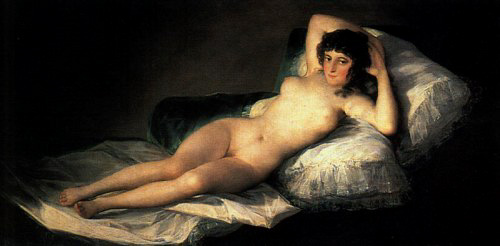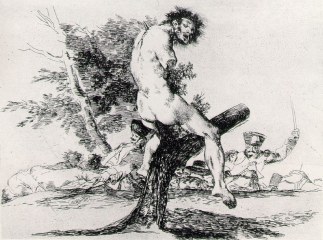Court scenes are bathed in golden ambient
light. The opening scene is a surrealist painting,
anachronistic by more than a century, but prefigured in
some of Goya's own works. One scene in the park looks
like an impressionist's dream, with sun-bathed saturated
greens and bright reds, this time about a half century
before their time. (If I get it correctly, Goya is
considered to be a precursor of modernism, so modernist
styles are shown as an extension of his mind.) Other
scenes look naturalistic. Anyway, the visuals are
generally creative portrayals of the inside of an
artist's mind - often mimimalistic and symbolic, allowing
a few characters to stand in place of many. Goya's
imaginings are in many different styles because he
employed many different painting styles through his long
life, and he had a major shift in the style and theme of
his work after a bout with fever that nearly killed him
when he was about 40.
Great
look.
Dull
movie.
Kind of
a lesson in Spanish art and politics, more suitable to a
classroom than a theater. I expected to hear those little
ringing noises which remind the teacher to move on to the
next image in the film strip.
|
The
Critics Vote
|
The People
Vote ...
- With their
votes ... IMDB summary: IMDb voters
score it 6.2 (very few votes), Apollo
users a pathetic 25/100.
- A bit under
a million U.S. gross, on the art house
circuit - about 25 screens.
|
| IMDb
guideline: 7.5 usually indicates a level of
excellence, about like three and a half stars
from the critics. 6.0 usually indicates lukewarm
watchability, about like two and a half stars
from the critics. The fives are generally not
worthwhile unless they are really your kind of
material, about like two stars from the critics.
Films under five are generally awful even if you
like that kind of film, equivalent to about one
and a half stars from the critics or less,
depending on just how far below five the rating
is. My own
guideline: A means the movie is so good it
will appeal to you even if you hate the genre. B means the movie is not
good enough to win you over if you hate the
genre, but is good enough to do so if you have an
open mind about this type of film. C means it will only
appeal to genre addicts, and has no crossover
appeal. D means you'll hate it even if you
like the genre. E means that you'll hate it even if
you love the genre. F means that the film is not only
unappealing across-the-board, but technically
inept as well.
Based on this
description, this film is a C-. Excessively
precious and pretentious film that will turn off
everyone except the art house crowd.
|
|


